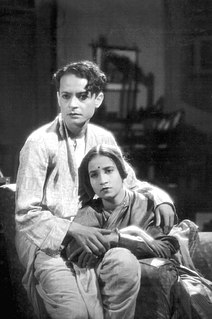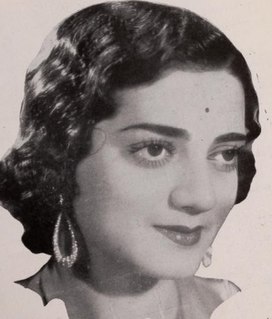Related Research Articles

Cinema of India consists of films produced in India. Cinema is immensely popular in India: every year, more than 1800 films are produced collectively in the various languages of India. Hyderabad, Mumbai, Chennai, Kolkata, New Delhi, Amritsar, Kochi, Bangalore, Bhubaneshwar-Cuttack and Guwahati are the major centres of film production in India. As of 2018, India ranked first in terms of annual film output. In 2015, India had a total box office gross of US$2.1 billion, the third largest in the world. The overall revenue of Indian cinema reached US$2.7 billion in 2019.

New Theatres is an Indian film studio. It was formed in Calcutta by producer B. N. Sircar. It was formed on 10 February 1931. Motto of this company was– Jivatang Jyotiretu Chhayam. Sircar preferred to function
roughly analogous to what in USA was known as an executive producer. He built a processing laboratory... and got around him a devoted band of people.... Having decided on or approved a story or a subject for a film and the team to make it [Sircar] ensured that adequate funds were provided... but refrained from interfering with its execution. He made New Theatres a symbol of Bengali cinema's artistic good taste and technical excellence.

Rai Chand Boral was an Indian composer, considered by music connoisseurs to be the Bhishma Pitamah, the father of film music in India.

Jahanara kajjan, or "Miss Kajjan", was an Indian singer and actress active during the 1920s and 1930s, often referred to as the "Nightingale of Bengal". The reigning queen of early Talkie movies glamorous movie sensation the trained classical singer, the fashion icon and the trendsetter, Jahanara Kajjan she was known as ‘Lark of Hindi cinema’ and the ‘Beautiful Nightingale of Bengal Screen’. She along with Master Nissar made most sought after and popular singing pair of the stage and Films.

Pramathesh Chandra Barua was an Indian actor, director, and screenwriter of Indian films in the pre-independence era, born in Gauripur.

Jamuna Barua was a leading Indian actress.

In Hinduism, Savitri and Satyavan are a legendary couple, known for Savitri's love and devotion to her husband Satyavan. According to the legend, princess Savitri marries an exiled prince named Satyavan, who was prophesied to die early. The later part of legend focuses on Savitri's wit and love, which saved her husband from the death god Yama.

Kanan Devi was an Indian actress and singer. She was among the early singing stars of Indian cinema, and is credited popularly as the first star of Bengali cinema. Her singing style, usually in rapid tempo, was used instrumentally in some of the biggest hits of New Theatres, Kolkata.
Gul Hamid or Gul Hamid Khan (1905-1936) was an Indian film actor. He started his acting career in silent films and later played leading roles in talkies. He had many honors to his credit. He acted in Heer Ranjha, the first film produced in Punjabi and in Seeta, a talkie that won an honorary diploma in the 1934 Venice Film Festival and that was also the first Indian film shown at an International film festival. Hamid also wrote the script, acted in, and directed the film Khyber Pass (1936). Hamid died of Hodgkin's Disease in 1936.
Dhirendra Nath Ganguly, better known as Dhiren Ganguly or D.G, was a Dadasaheb Phalke Award-winning and Padma Bhushan recipient film entrepreneur/actor/director of Bengali Cinema. He had set up a number of film production companies: Indo British Film company, British Dominion Films, Lotus Film Company. Later, he directed films for New Theatres. He produced many movies in the comedy genre. He was born in Calcutta and died in the same city.

Debaki Bose (1898–1971), Padma Shri, also known as Debaki Kumar Bose, was an Indian director, writer, and actor who is recognized for his contribution in Hindi as well as Bengali cinema. He was born on 25 November 1898 in Akalposh,, Burdwan, Bengal, British India. He died on 17 November 1971 in Calcutta, West Bengal, India. He is known for his innovative use of sound and music in Indian Cinema. He worked first under the banner of British Dominion Films of Dhiren Ganguly and later with Pramathesh Barua's Barua Pictures and finally he joined New Theatres banner in 1932. He started his own production company, Debaki Productions, in 1945.

Nitin Bose was an Indian film director, cinematographer and screenwriter of the nation's film industry. He was born in Calcutta and died in the same city. In the 1930s and early 1940s, he worked with New Theatres, who made bilingual movies: in both Bengali and Hindi. Later, he moved to Bombay and directed under the banners of Bombay Talkies and Filmistan.
Premankur Atorthy (1890–1964) was an Indian novelist, journalist, and film director. He was involved in Hindi and Bengali cinema.
Vemuri Gaggaiah (1895–1955) was an Indian film actor, character actor, singer, and thespian known for his works in Telugu cinema, and Telugu theater. In 1933, East India Film Company produced its first Indian film, Savitri, in Telugu. Shot in Calcutta on a budget of ₹ 75 thousand, and based on a popular stage play by Mylavaram Bala Bharathi Nataka Samajam, the film was directed by the father of the "Telugu Theater Movement", Chittajallu Pullaiah, casting Vemuri Gaggaiah and Dasari Ramathilakam as "Yama" and "Savithri" respectively. The blockbuster film has received an honorary diploma at Venice Film Festival.

Savitri is a 1933 Indian Telugu language drama film directed by C. Pullaiah. It was based on a popular stage play of Mylavaram Bala Bharati Samajam. It was the first film produced by East India Film Company with an estimated budget of ₹75,000 in Calcutta. The blockbuster film has received an honorary diploma at the 2nd Venice International Film Festival. The story is about Savitri and Satyavan from Mahabharata. According to the legend, Princess Savitri marries Prince Satyavan despite a curse that foretells his death within a year. She manages to get Yama, the god of death, to restore her husband to life.

Chittajallu Pullayya, also known as C. Pullayya, was an Indian film director, known for his works predominantly in Telugu cinema. He is regarded as the father of Telugu theatre movement. In 1933, he made his film directorial debut with East India Film Company's first Indian film Sati Savitri which has received honorary diploma at Venice Film Festival. He then directed Sati Anasuya, the first children's film and Lava Kusa (1934).

Birendranath Sircar was an Indian film producer and the founder of New Theatres Calcutta. He made Bengali-language films that were noted for introducing many film directors who later became famous. He was awarded the Dada Saheb Phalke Award in 1970 and the third highest civilian award in India, the Padma Bhushan, in 1972.

Seeta was a 1933 Indian talkie Bengali film, directed by Debaki Bose and produced by the East India Film Company. It won an honorary diploma in the 2nd Venice International Film Festival in 1934, becoming the first Indian talkie to be shown at an international film festival. The film starred Gul Hamid, Prithviraj Kapoor as Rama, and Durga Khote as Sita.

Sabita Devi (1914–1965) was a Hindi film actress in Indian cinema. She is stated to be one of the "prominent" leading ladies of the "pioneering era" of Indian cinema along with Mehtab, Bibbo, Durga Khote, Gohar, Devika Rani and Seeta Devi. A Jewess by birth, she changed her name to find acceptability in Hindi cinema like the other Anglo-Indian and Jewish actresses of her time, Sulochana, Seeta Devi, Madhuri, and Manorama. After initially working with British Dominion Films Ltd., Calcutta, she shifted to Bombay and performed mainly in films produced by Sagar Movietone with her co-star in most films being Motilal. Some of the popular films with Motilal were Dr. Madhurika (1935) and Kulvadhu (1937) directed by Sarvottam Badami. Their first film together was Shaher Ka Jadoo (1934), which was also Motilal's debut film, and then Lagna Bandhan (1936) both directed by Kaliprasad Ghosh. She acted in Silver King (1935) with Motilal. It was an action film directed by C. M. Luhar, which became a "huge success".

Dhiraj Bhattacharya was an actor of Bengali and Hindi cinema who began in silent films. He was also a theater personality and writer.
References
- 1 2 3 4 5 Sharmistha Gooptu (2010). Bengali Cinema: An Other Nation. Taylor & Francis. p. 69. ISBN 978-0-415-57006-0.
- ↑ Erik Barnouw; S. Krishnaswamy (1980). Indian film. Oxford University Press. p. 113. ISBN 0-19-502682-9.
- ↑ Asha Kasbekar (2006). Pop culture India!: media, arts, and lifestyle. ABC-CLIO. p. 216. ISBN 1-85109-636-1.
- 1 2 Bhagwan Das Garg (1996). So many cinemas: the motion picture in India. Eminence Designs. p. 86. ISBN 81-900602-1-X.
- ↑ T. M. Ramachandran (1985). 70 years of Indian cinema, 1913-1983. CINEMA India-International. p. 79. ISBN 0-86132-090-5.
- ↑ Narasimham, M. L. (7 November 2010). "SATI SAVITHRI (1933)". The Hindu . Retrieved 8 July 2011.